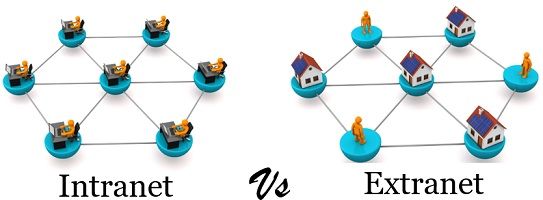 Intranet and extranet are derived from a global network that we refer to as the Internet. An intranet is a private network established inside an organisation to let all employees communicate and share resources. However, an extranet is a private network that authenticated users outside the organisation can access via a network password.
Intranet and extranet are derived from a global network that we refer to as the Internet. An intranet is a private network established inside an organisation to let all employees communicate and share resources. However, an extranet is a private network that authenticated users outside the organisation can access via a network password.
The users inside the organisation only use the intranet. However, the users inside and the authorised users outside the organisation use the extranet. This section will identify all the possible differences between these two types of networks.
Content: Intranet Vs Extranet
Comparison Chart
| Basis for Comparison | Intranet | Extranet |
|---|---|---|
| Basic | It's a private network that enables all enterprise employees to communicate with each other. | It's a private network that enables the enterprise to connect with its suppliers, customers, vendors etc. |
| User | It caters for all employees of the organisation. | It caters to all employees of the organisation and the partners connected to it. |
| Security | Security is ensured by implementing a Firewall. | Security is ensured by implementing VPN over internal security. |
| Security level | Highly secure | Comparatively less secure |
| Owner | Owned and managed by a single organisation | Owned and managed by the multiple connected organisations |
| An intranet is a private network. | An extranet is a private network that uses a public network (Internet) to share information with connected partners. | |
| Used for | Used to securely share the organisation's information and computing resources among the employees | Use to check the status of the services/products, send emails, access data, place orders, etc. |
| Network Size | Restricted up to a particular area of the organisation | Comparatively larger than the intranet |
| Example | HCL uses the internal network to share information with their employees | HCL uses an extranet to share information with their stakeholders |
What is Intranet?
An intranet uses the Internet in an isolated facility internal to an organisation. It is designed to use inside an organisation so all employees can securely access its shared resources.

An intranet is a private local area network limited to users inside the organisation. However, this private network can use the applications defined for the global Internet, such as HTTP, and can have a file server, database server, web server, etc.
How Does Intranet Work?
Intranet works the same as the Internet, with the difference that its network is confined to the organisation only. Now, this website, i.e. techdifferences.com, is stored on a Web server connected to the Internet. So, any user across the world connected to the Internet can access this website.

However, the employees of TechDifferences are using the website tdintra.com to read messages from the company’s head, post events on companies’ calendar, and access the company’s private data. Now the website tdsintra.com is stored on the TechDifferences office in Bangalore’s web server, which is only connected to the organisation’s local area network. Only employees of this particular organisation can access tdsintra.com via an intra-network password.
It uses the same communication standards as the Internet, i.e. TCP/IP.
Advantages of Intranet
- Enhances internal communication within the organisation.
- Connects the employees of the organisation across the locations. Such as it connects employees that are not physically close, which is helpful for teamwork.
- It helps the organisation’s employees access the organisation’s private data and computing resources.
- It is a great network to publish the organisation’s announcements, awards, etc.
- Useful in securely exchanging information between the employees of the organisation.
What is Extranet?
The extranet is similar to the intranet, with one major difference. The extranet extends the Intranet over the Internet to allow a selected group of users, such as customers, suppliers, and mobile workers, to access the organisation’s private data and applications.

Usually, organisations with many users across the location and time zone use the extranet, such as suppliers, vendors, partners, clients, customers, etc., of the organisations. An extranet creates a virtual private network to share sensitive information securely.
So, only the authenticated user can access the extranet via the network password. Extranet uses a firewall, VPN, digital certificate, etc., to secure communication between the organisation and its suppliers, customers, etc. Even the extranet uses the same communication standard as we use for the Internet, i.e. TCP/IP.
Example of Extranet
Consider that an organisation sets up a private network. The authorised users outside the organisation can connect to this private network over the Internet to access the organisation’s sensitive information. This helps organisations to communicate with their business partners, customers, clients etc.
Like, Amazon exchanges information with its customer and suppliers.
Advantages of Extranet
- The main advantage of an extranet is network sharing, which allows the organisation to communicate with users outside the organisation.
- Network sharing enhances data exchange between the organisation and the users connected to it.
- Creating a virtual private network extranet allows secure communication.
Key Differences Between Intranet and Extranet
- An intranet is a private network formed by the organisation where access to the network is restricted to the users inside the organisation. However, the extranet is a private network where some of the organisation’s resources can be accessed by a specific group outside the organisation under the network administrator’s control.
- Usually, the employees inside the organisation use the intranet formed by the organisation. In contrast, the employees inside the organisation and some specific groups related to the organisation, such as suppliers, customers, and mobile workers outside the organisation, use the extranet.
- To ensure security intranet implements a firewall that filters the incoming and outgoing traffic depending on the organisation’s policies. On the contrary, the extranet uses a VPN to access the organisation’s private network over the Internet.
- The level of security is higher in the intranet as no one outside the organisation accesses this private network. Comparatively, the extranet could be less secure as the third-party users that are relevant to the organisation can also access the intranet over the Internet.
- Organisations use the intranet to share their private data and computing resources between employees securely. However, organisations use an extranet to share their data with users outside the organisation, enabling authorised customers to access product specifications, availability, and online ordering.
- The intranet is owned by the organisation that forms the intranet. Conversely, the extranet is owned and managed by the multiple groups accessing it.
- An intranet is a private network, whereas an extranet is also a private network that uses a public network (Internet) to share information with a specific group outside the organisation.
- Organisations especially use the intranet to let their employees securely communicate with each other and share the organisation’s private data and resources. However, an extranet is used by organisations to check the status of services/products, send emails, access data, place orders, etc.
- The network size of the intranet is comparatively smaller than the extranet as the intranet and restricted internally to an organisation. In contrast, the extranet is extended to organisations, their suppliers, customers, and mobile workers of the organisation.
Conclusion
So, we can conclude that intranet and extranet differ with one major difference. The users inside the organisation access intranet. In contrast, the users inside and authenticated outside the organisation access the extranet.
Leave a Reply